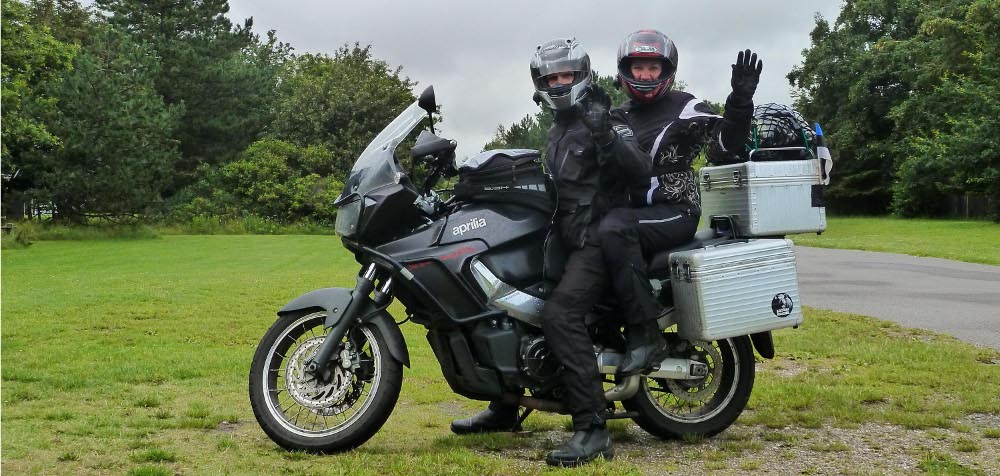Tänase päeva teekond viis meid läbi Jüütimaa põhjaosa, sealt edasi praamile, mis viis meid Rootsi. Kaardi peal näeb see kõik välja nii.
Today’s journey took us through the northern part of Jutland, then onto a ferry that took us to Sweden. On the map, it all looks like this.
Meie esimeseks peatuskohaks oli Råbjerg Mile. See on väga huvitav moodustis, millest tahaksin kohe pikemalt rääkida. Tegemist on suure liivadüüniga, mis liigub pidevalt edasi. Teadlaste arvutuste järgi peaks düün umber 175 aasta pärast matma enda alla lähedal asuva raudtee ja maantee. Päris nii hull ilmselt asi siiski pole, sest tänapäeval on olemas tehnoloogiad selle liikumise peatamiseks.
Our first stop was Råbjerg Mile. This is a very interesting formation that I would like to talk about in more detail. It is a large sand dune that constantly moves forward. According to scientists’ calculations, the dune is expected to bury the nearby railway and highway in about 175 years. However, it probably won’t be that drastic, as there are technologies available today to stop its movement.

Selle düüni tekkelugu on ka põnev. Düün sai alguse kahe sündmuse tõttu, esiteks väike jääaeg, mille ajal langesid temperatuurid kuni 2 kraadi võrra ja inimtegevus, mille käigus hävines liival kasvav taimestik. Väikese jääaja ühel perioodil mere veetase langes ja see võimaldas tuulel peenemaid liivaterasid lendu puhuda. Selle tulemusel moodustuski esialgne düün. See neelas endasse kaldal juba olemas olvad väiksemad rannadüünid ja muutus järjest suuremaks. Tuule mõjul liikus ta edasi sisemaa poole ja mattis enda alla puud kui ka ette jäänud talud. Selle tõttu pidid talunikud oma maadelt ära kolima.
The formation history of this dune is also fascinating. The dune originated due to two events: first, the Little Ice Age, during which temperatures dropped by up to 2 degrees, and human activity, which destroyed the vegetation growing on the sand. During one period of the Little Ice Age, the sea level dropped, allowing the wind to blow finer sand particles into the air. As a result, the initial dune formed. It absorbed the smaller coastal dunes already present on the shore and grew larger. Driven by the wind, it moved inland, burying trees and any farms in its path. Because of this, farmers had to abandon their land.

Tänasel päeval on düün konserveeritud ja riik on ostnud maa, selle ümbruses. Tegemist on olulise vaatamisväärsusega, mida külastab palju turiste. See oli tõesti muljetavaldav vaatepilt, mis meenutas kõrbe või hoopis mõnda võõrast planeeti. Soovitan seda soojalt kõigile, kes sinna kanti satuvad.
Today, the dune is preserved, and the state has purchased the land around it. It is an important tourist attraction that many visitors come to see. It was truly an impressive sight, reminiscent of a desert or even an alien planet. I highly recommend it to anyone who finds themselves in the area.
Oma lõunapausi tegime linnakeses nimega Skagen. See on Taani kõige põhjapoolsem linn. Tegemist on väikese armsa linnakesega, mis on tuntud oma kollaste majade poolest.
We took our lunch break in a small town called Skagen. It is the northernmost town in Denmark. It is a charming little town known for its yellow houses.

Veidi negatiivne asjaolu Skagenis oli see, et sadama-ala, oli turistidest üleküllastunud. Kõigest hoolimata sõime mõnusalt krõbedat kalafileed koos krevettidega ja nautisime sadama melu.
A slightly negative aspect of Skagen was that the harbor area was overcrowded with tourists. Despite everything, we enjoyed a nice crispy fish fillet with shrimp and soaked in the harbor’s lively atmosphere.

Taanis oli olnud üldiselt jahe ilm ja ilmateade ei lubanud eriti midagi head ka tänaseks. Tegelikkuses aga oli imeilus ja soe ilm. Skagenis hakkas juba päris kuum. Seetõttu tegime mere ääres umbes pooletunnise peatuse, mille käigus õnnestus mul ka sellel aastal esimest korda meres ujumas käia. Inge arvas küll, et ega see õige ujumine ei onud, pigem selline kiire vetteistumine. Nagu alati oli tal õigus, sest vesi oli üsna karge.
Sealt edasi suundusime Frederikshavn’i sadamasse kust meid praam viis Göteborgi. Meie öömaja on täna linnakeses nimega Mölnlycke. Kui veab, siis on ehk sellest mõni pilt järgmises postituses. Homme ongi viimane sõidupäev. Eesmärk on õhtuks jõuda Kappelskäris praamile, mis peaks meid siis ülehomme hommikul Paldiskis maha panema.
The weather in Denmark had generally been cool, and the forecast didn’t promise much good for today either. However, it turned out to be a wonderfully beautiful and warm day. In Skagen, it even got quite hot. Therefore, we made about a half-hour stop by the sea, during which I managed to go for my first swim in the sea this year. Inge did say that it wasn’t really swimming, more like a quick dip. As always, she was right, because the water was quite chilly.
From there, we headed to the port of Frederikshavn, where a ferry took us to Gothenburg. Our accommodation tonight is in a small town called Mölnlycke. If we’re lucky, there might be a picture of it in the next post. Tomorrow is our last driving day. The goal is to reach the ferry in Kapellskär by the evening, which should then drop us off in Paldiski the morning after tomorrow.




